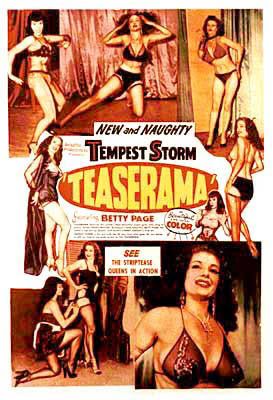
Some people might be surprised to discover that during the height of its 1950s popularity, the art of burlesque thrived not only on the stage but on the screen as well.
Of course, even those with just a passing interest in burlesque are aware of such films as Striporama (1953), Varietease (1954) and Teaserama (1955), all of which attained a new level of notoriety in the early-1990s, thanks to the appearances in them by Bettie Page, whom at that stage had been rediscovered and established as the defining cheesecake pin-up of her generation. Some people may even be aware of mainstream films which flirted with the art, such as the 1943 Barbara Stanwyck B-picture Lady of Burlesque. However, the burlesque film genre runs surprisingly much deeper than these few titles.
While traditional burlesque as a live performance art has been around for over one hundred years, its cinematic popularity peaked in the in the first half of the fifties. Spurred on by a slight relaxing in film censorship laws, as well as the huge influx of young GIs who had returned from combat in Europe and the Pacific – where they had no doubt been exposed to forms of entertainment more risqué than what they had been used to seeing at home – the burlesque film genre began to appear more and more often, usually screening in small, low-rent cinemas that catered to exploitation films, as well as in men’s clubs and even as warm-up entertainment for live girlie shows themselves.
Extremely simplistic in their production, most burlesque films from this period were little more than live shows captured on celluloid, an economic move on behalf of the filmmakers which fifty years later makes them authentic (and important) time capsules of their era, as they often included not only the dancing and stripteaser girls, but the ‘comedy’ and variety acts that were used to pad out the shows and keep the audience entertained while the gals backstage changed costumes and got ready to take the stage once again. Apart from the aforementioned Bettie Page, other notable performers who appeared in vintage burlesque films include Lili St. Cyr, Tempest Storm and Blaze Starr.
One of the most popular types of burlesque film were those which focused on the naughty nightlife of a particular (and usually exotic) city. The notorious George Weiss (Glen or Glenda) was one exploitation producer who favoured this style of film, putting together a string of ‘After Midnight’ titles in the early-fifties, including Paris After Midnight (1951), Bagdad After Midnight (1954) and Tijuana After Midnight (also 1954). Other similar titles in this genre include Burlesque in Harlem (1950), Burlesque in Hawaii (1953), Naughty New York (1959) and 1964’s Naughty Dallas (directed by schlockmeister Larry Buchanan of Mars Needs Women fame and filmed inside Jack Ruby’s nightclub).
Occasionally, some burlesque films would try to incorporate some semblance of a plot into them. In Joseph P. Mawra’s The Peek Snatchers (1965), a small TV-like device discovered by two perverts allows them to tune in and watch dancing girls perform on stages all over the world, while Striptease Murder Case (1950) injects some cheesy whodunit elements into its proceedings (with predictably ludicrous results).
Apart from features, burlesque shorts were also a popular form of entertainment amongst hot blooded men during the 1950s. These were usually shot on 8mm and presented as ‘loops’ in peep machines, or sold through the pages of men’s magazines for home viewing (they would become particularly popular at stag parties).
As nudie-cutie and sexploitation films became more popular – and risqué - in the early 1960s (thanks to filmmakers such as Russ Meyer, Doris Wishman and Herschell Gordon Lewis), the burlesque genre eventually withered and died, only to live again decades later, thanks to the home video and DVD revolutions.
Sources:
Many of the films mentioned in this article – as well as many others – are available on VHS and DVD from Something Weird Video (
John Harrison 2009


